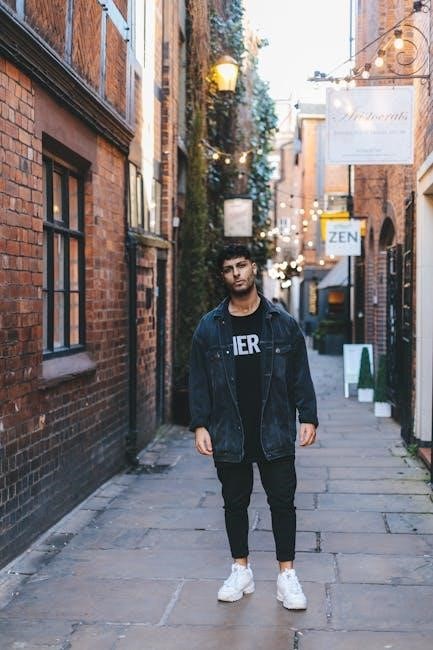Understanding Personal Style
Understanding personal style involves self-expression through color, fit, and confidence. It’s about mastering wardrobe essentials and creating a timeless look that reflects individuality and personal flair seamlessly.
The Importance of Color Matching in Men’s Fashion
Color matching is a cornerstone of men’s fashion, as it elevates outfits from ordinary to extraordinary. Understanding how colors complement each other ensures a polished, cohesive look. Neutrals like navy, black, and gray serve as versatile bases, while bold colors can add personality. A well-balanced palette creates harmony, making an outfit more visually appealing. The 60-30-10 rule—60% dominant color, 30% secondary, and 10% accent—offers a practical guide for mixing hues effectively. Additionally, considering skin tone and hair color helps in selecting flattering shades. For instance, cooler tones suit lighter complexions, while warmer tones complement deeper skin tones. Experimenting with color wheels and seeking inspiration from fashion experts can refine this skill. Mastering color matching transforms a man’s wardrobe, ensuring every outfit reflects confidence and style.
Dressing According to Body Type
Dressing according to body type is crucial for a flattering and confident look. Understanding your physique—whether ectomorph, mesomorph, or endomorph—helps in selecting clothes that enhance your natural proportions. For ectomorphs, layering and structured fits create the illusion of muscle mass, while slim-fit shirts and tailored trousers avoid a boxy appearance. Mesomorphs can embrace balanced silhouettes, such as fitted jackets and straight-leg jeans, to highlight their athletic build. Endomorphs benefit from streamlined outfits, like dark colors and vertical stripes, to create a slimmer profile. Avoiding oversized or too-tight clothing is key for all body types. Tailoring ensures a perfect fit, while proportions and fabric choice further refine the look. By aligning wardrobe choices with body type, men can achieve a polished, personalized style that accentuates their strengths and minimizes weaknesses.
Wardrobe Audits and Essentials
A wardrobe audit is the cornerstone of building a stylish and functional closet. It involves assessing current pieces, identifying gaps, and ensuring every item aligns with personal style. Essentials like a classic white shirt, well-fitted jeans, and a versatile blazer form the foundation of a timeless wardrobe. These pieces can be mixed and matched to create multiple outfits, offering versatility for various occasions. Regular audits help maintain a curated collection, preventing clutter and ensuring each item is worn and loved. Quality over quantity is key, as investment pieces often outlast fast fashion. A streamlined wardrobe not only simplifies daily dressing but also enhances confidence, ensuring a cohesive and polished look. By focusing on essentials, men can effortlessly elevate their style while minimizing decision fatigue.
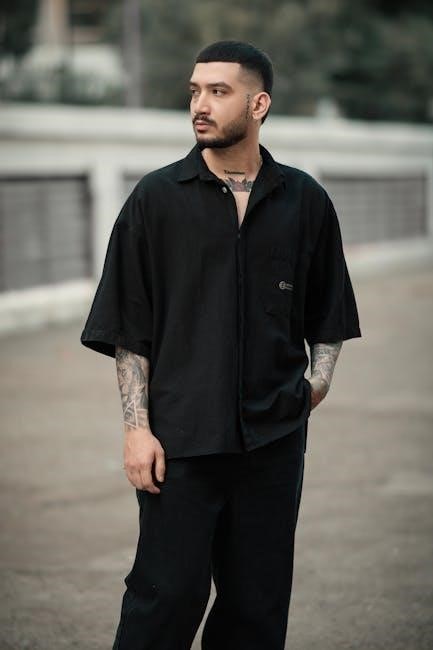
Essential Items for Every Man’s Wardrobe
A well-rounded wardrobe starts with timeless pieces like classic dress shirts, dark denim, and versatile blazers. Quality footwear, leather accessories, and a tailored suit are indispensable for polished looks.
Classic Dress Shirts and Their Versatility
A classic dress shirt is a cornerstone of men’s fashion, offering unmatched versatility. Available in various fits—slim, regular, or relaxed—it can be styled for both formal and casual occasions. White and light-blue shirts are timeless choices, while subtle patterns like stripes add diversity. Pairing them with tailored trousers creates a polished look, or layer under a blazer for sophistication. For a relaxed vibe, they can be worn with dark denim and sneakers. Details like cuff styles and collar types further personalize the look. Investing in high-quality fabrics ensures comfort and durability. A well-fitted dress shirt elevates any outfit, making it a must-have in every wardrobe. By experimenting with colors and patterns, men can effortlessly adapt this essential piece to suit their personal style and occasion, ensuring a sharp, put-together appearance every time.
The Role of Denim in Modern Fashion
Denim remains a cornerstone of modern men’s fashion, offering unparalleled versatility. From classic blue jeans to contemporary black and gray options, denim is a wardrobe staple that transcends trends. It can be dressed up or down, making it suitable for casual outings, smart-casual events, and even some formal settings when paired with tailored pieces. Slim-fit, straight-leg, and relaxed styles cater to diverse body types and preferences. Modern designs incorporate innovative washes, distressing, and sustainable fabrics, appealing to eco-conscious consumers. Layering a denim jacket over a dress shirt or pairing jeans with a blazer creates a chic, contemporary look. Denim’s adaptability ensures it remains a timeless essential, seamlessly integrating into any man’s wardrobe for both everyday comfort and polished sophistication.
Footwear Choices That Elevate an Outfit
Footwear plays a pivotal role in elevating a man’s outfit, serving as the finishing touch that ties the entire look together. The right shoes can instantly enhance elegance, professionalism, or casual charm, depending on the occasion. Classic options like leather oxfords or loafers are timeless choices for formal and business-casual settings, while sleek sneakers or boots add a modern edge to everyday attire. Seasonal appropriateness is key—opt for breathable, lightweight styles in summer and sturdy, insulated options in winter. Comfort and quality are equally important, as they ensure longevity and confidence. Pairing footwear with complementary colors and textures creates a cohesive, polished look. Whether dressing up or keeping it casual, the right shoes can transform an ordinary outfit into an extraordinary one, making them an essential investment in any man’s wardrobe.
Dress Codes for Men
Dress codes for men range from formal to casual, guiding attire choices for various occasions. Understanding these codes ensures confidence and appropriateness, making a lasting style statement.
Formal Attire: Black Tie and Beyond
Formal attire, particularly black tie, represents the pinnacle of men’s fashion. A classic tuxedo is essential, featuring a single or double-breasted jacket, matching trousers, and a bow tie. Black tie events demand precision, with a focus on luxurious fabrics like wool or silk. Accessories such as cufflinks, a pocket square, and patent leather shoes elevate the look. The fit is crucial; a well-tailored suit ensures elegance and sophistication. For ultra-formal occasions, a white tie ensemble, including a tailcoat and starched shirt, is required. Modern variations may allow subtle personal touches, like a patterned bow tie or a boutonniere, while maintaining the overall refinement. Attention to detail, from the shine of shoes to the crispness of the shirt, ensures a polished appearance. Mastering formal attire is about understanding tradition while embracing individual flair, making it a cornerstone of timeless style.
Business Casual: Striking the Right Balance
Business casual is a versatile and polished style that blends professionalism with relaxed elements. It typically includes tailored trousers, dress shirts, and blazers paired with loafers or dress boots. Jeans can be incorporated if dark-washed and fitted well. The key is to maintain a sharp look while avoiding overt formality. Layering, such as a sweater or cardigan over a button-down shirt, adds depth and adaptability. Accessories like a leather belt or minimalist watch can enhance the outfit. Fit is crucial, as baggy clothes undermine the polished aesthetic. Quality materials, such as wool or cotton, ensure a refined appearance. Business casual is ideal for office environments, client meetings, or networking events, allowing a man to look professional yet approachable. Balancing comfort and style, it’s a timeless choice for modern men seeking versatility in their wardrobe.
Smart Casual: Versatility in Everyday Looks
Smart casual is a refined yet relaxed style perfect for everyday occasions. It emphasizes clean, well-fitted pieces like polo shirts, dark-washed jeans, and tailored trousers. A blazer or leather jacket adds sophistication, while loafers or sneakers provide versatility. Layering with a cardigan or sweater creates depth and adaptability. Accessories like a watch or simple necklace enhance the look without overcomplicating it. The key is to balance comfort and style, ensuring clothes fit well and exude confidence. Smart casual is ideal for casual meetings, dinner dates, or social gatherings, offering a polished yet approachable aesthetic. It’s about mixing and matching essentials to craft a look that’s effortlessly put-together, making it a cornerstone of modern men’s wardrobes.
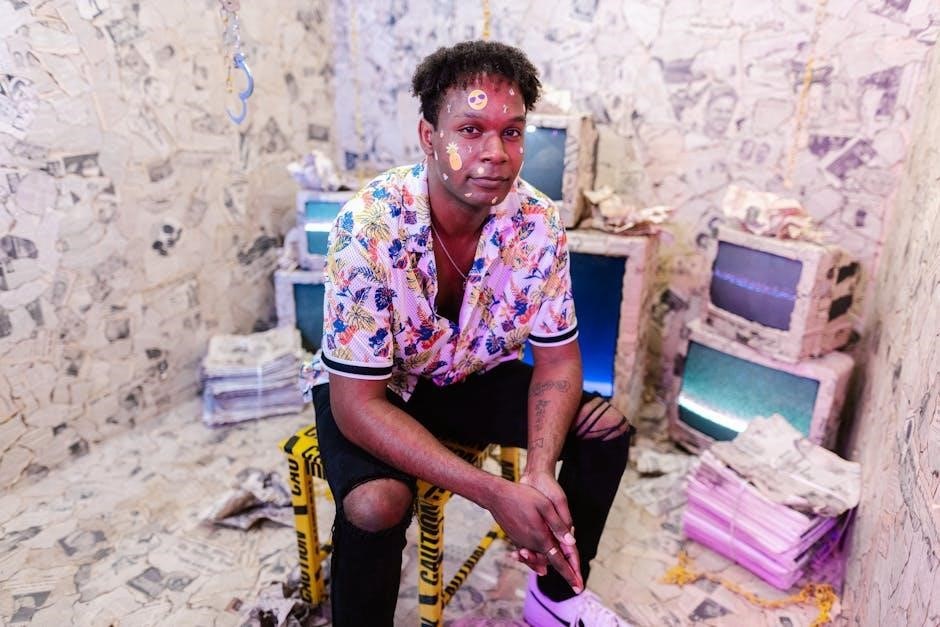
Seasonal Fashion Tips
Seasonal fashion tips focus on adaptability, using lightweight fabrics in spring, breathable materials in summer, and layering for fall and winter, ensuring comfort and style year-round effortlessly.
Spring Fashion: Lightweight Fabrics and Colors
Spring fashion for men emphasizes freshness and comfort, focusing on lightweight fabrics like linen, cotton, and chambray. These materials breathe easily, keeping you cool in warmer weather. Pastel colors and soft neutrals dominate the season, offering a clean and modern aesthetic. Incorporating these hues into dress shirts, chinos, or blazers creates a versatile wardrobe. Pairing light jackets with tailored trousers or jeans strikes a balance between style and practicality. Accessories like leather sandals or slip-on sneakers enhance the seasonal look. Layering thin fabrics, such as a cotton sweater over a dress shirt, adds depth without heaviness. Embrace the season’s vibrancy by experimenting with subtle patterns like stripes or floral accents. Remember, spring is about effortless elegance and transitional pieces that bridge winter and summer seamlessly.
Summer Style: Breathable Materials and Comfort
Summer style for men prioritizes comfort and breathability, focusing on lightweight fabrics like linen, cotton, and chambray. These materials wick moisture and keep you cool in the heat. Opt for pastel-colored shirts, white linen pants, or seersucker suits for a fresh, seasonal look. Shorts are a staple, paired with button-down shirts or polo tees for versatility. Loafers, sandals, or slip-on sneakers complement the outfit while maintaining comfort. Don’t shy away from bold yet breathable patterns like tropical prints or stripes to add personality.Accessorize with a Panama hat or sunglasses for both style and functionality. Layering is minimal, but a lightweight blazer can elevate a simple ensemble. Summer fashion is about balancing practicality with elegance, ensuring you stay cool and confident throughout the season.
Fall and Winter Fashion: Layering and Warmth
Fall and winter fashion emphasizes layering and warmth, blending practicality with style. Start with a base layer of thermal underwear or a thin sweater, then add a button-down shirt or knitwear. Outerwear like wool overcoats, parkas, or leather jackets provides insulation. Incorporate warm fabrics such as wool, cashmere, and flannel for depth and texture. Earthy tones like olive, navy, and charcoal dominate the season, but rich colors like burgundy and mustard add vibrancy. Footwear shifts to leather boots or rugged sneakers for traction and durability. Accessories like scarves, gloves, and beanies enhance both warmth and style. Layering creates versatility, allowing you to adjust to changing temperatures while maintaining a polished look. Balance heavy textures with fitted silhouettes to avoid bulkiness, ensuring a refined yet cozy winter wardrobe.
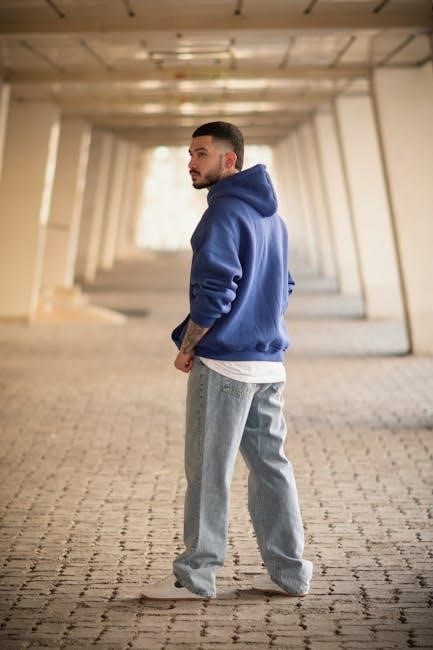
Styling Tips and Tricks
Mastering fit, experimenting with color, and layering are key to enhancing your wardrobe. Small details like cuffing pants or rolling sleeves can elevate everyday looks effortlessly and confidently.
Mastering the Art of Layering
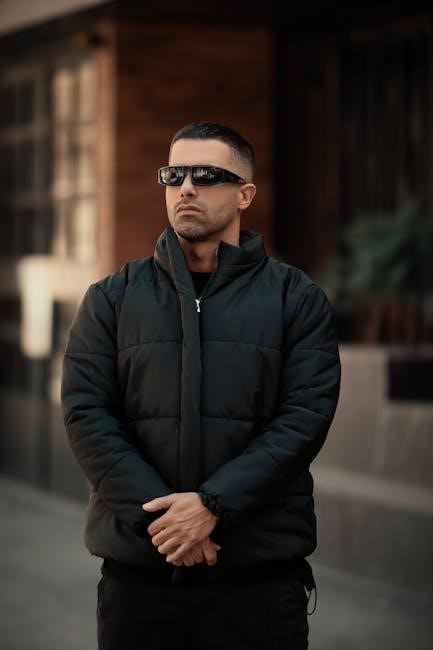
Layering is a cornerstone of stylish outfits, allowing men to adapt to changing environments while maintaining a polished look. Start with a thin, breathable base layer like a cotton or linen shirt, followed by a mid-layer such as a fleece or sweater for added warmth and texture. Finally, complete the ensemble with an outer layer like a leather jacket or coat. This approach ensures versatility, as layers can easily be added or removed based on the setting. Balance is key—avoid overloading with too many pieces, as this can create a bulky appearance. Mix patterns and textures thoughtfully to add depth without clashing. Accessories like scarves can enhance both style and functionality. Remember, confidence pulls the look together, making even the simplest layered outfits effortlessly stylish.
